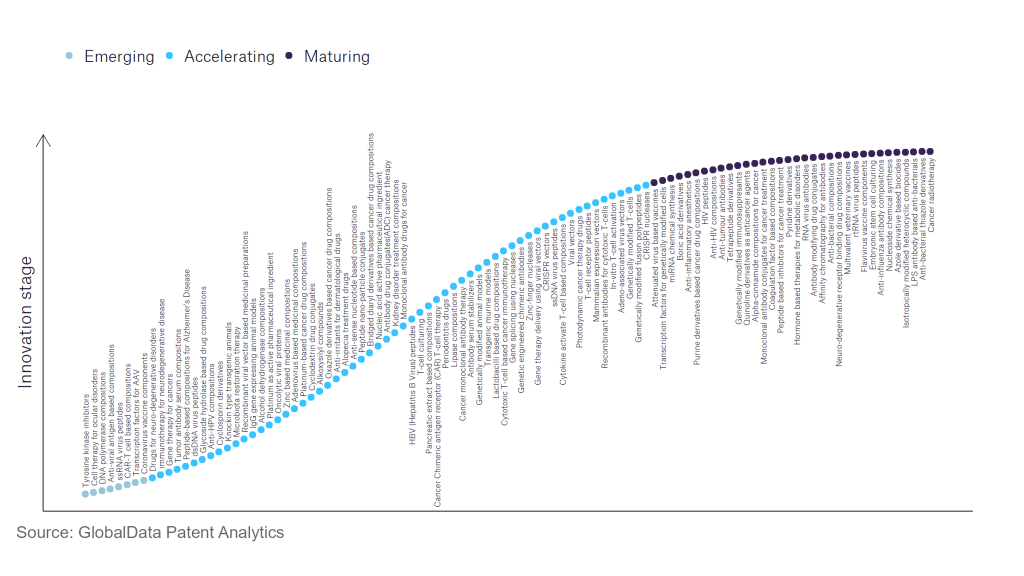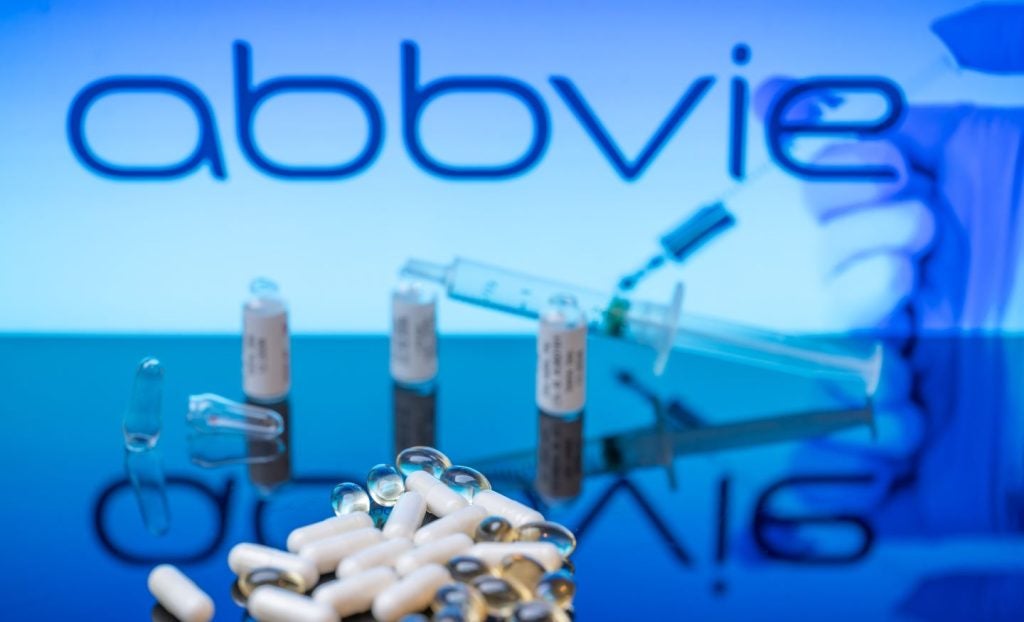The pharmaceutical industry continues to be a hotbed of innovation, with activity driven by the evolution of new treatment paradigms, and the gravity of unmet needs, as well as the growing importance of technologies such as pharmacogenomics, digital therapeutics, and artificial intelligence. In the last three years alone, there have been over 633,000 patents filed and granted in the pharmaceutical industry, according to GlobalData’s report on Innovation in Pharmaceuticals: Mammalian expression vectors. Buy the report here.
However, not all innovations are equal and nor do they follow a constant upward trend. Instead, their evolution takes the form of an S-shaped curve that reflects their typical lifecycle from early emergence to accelerating adoption, before finally stabilising and reaching maturity.
Identifying where a particular innovation is on this journey, especially those that are in the emerging and accelerating stages, is essential for understanding their current level of adoption and the likely future trajectory and impact they will have.
110 innovations will shape the pharmaceutical industry
According to GlobalData’s Technology Foresights, which plots the S-curve for the pharmaceutical industry using innovation intensity models built on over 756,000 patents, there are 110 innovation areas that will shape the future of the industry.
Within the emerging innovation stage, cell therapy for ocular disorders, coronavirus vaccine components, and DNA polymerase compositions are disruptive technologies that are in the early stages of application and should be tracked closely. Adeno-associated virus vectors, alcohol dehydrogenase compositions, and antibody serum stabilisers are some of the accelerating innovation areas, where adoption has been steadily increasing. Among maturing innovation areas are anti-influenza antibody compositions and anti-interleukin 1, which are now well established in the industry.
Innovation S-curve for the pharmaceutical industry

Mammalian expression vectors is a key innovation area in pharmaceutical
Mammalian expression vectors are used to introduce a specific fragment of DNA into mammalian systems for RNA or protein expression. These systems include human and mouse cell lines, and even in vivo in live animals. Mammalian expression vectors are often considered to be more beneficial for the expression of mammalian genes due to the similarity in cellular machinery.
GlobalData’s analysis also uncovers the companies at the forefront of each innovation area and assesses the potential reach and impact of their patenting activity across different applications and geographies. According to GlobalData, there are 160+ companies, spanning technology vendors, established pharmaceutical companies, and up-and-coming start-ups engaged in the development and application of mammalian expression vectors.
Key players in mammalian expression vectors – a disruptive innovation in the pharmaceutical industry
‘Application diversity’ measures the number of different applications identified for each relevant patent and broadly splits companies into either ‘niche’ or ‘diversified’ innovators.
‘Geographic reach’ refers to the number of different countries each relevant patent is registered in and reflects the breadth of geographic application intended, ranging from ‘global’ to ‘local’.
Patent volumes related to mammalian expression vectors
| Company | Total patents (2021 - 2023) | Premium intelligence on the world's largest companies |
| CRISPR Therapeutics | 163 | Unlock Company Profile |
| E. Merck | 157 | Unlock Company Profile |
| Regeneron Pharmaceuticals | 139 | Unlock Company Profile |
| Editas Medicine | 133 | Unlock Company Profile |
| Immatics | 118 | Unlock Company Profile |
| Inscripta | 91 | Unlock Company Profile |
| Takeda Pharmaceutical | 91 | Unlock Company Profile |
| Massachusetts General Hospital | 80 | Unlock Company Profile |
| Kirin Holdings | 77 | Unlock Company Profile |
| Caribou Biosciences | 76 | Unlock Company Profile |
| F. Hoffmann-La Roche | 69 | Unlock Company Profile |
| Corteva | 66 | Unlock Company Profile |
| C. H. Boehringer Sohn | 65 | Unlock Company Profile |
| Sangamo Therapeutics | 59 | Unlock Company Profile |
| Vertex Pharmaceuticals | 58 | Unlock Company Profile |
| Intellia Therapeutics | 52 | Unlock Company Profile |
| Daiichi Sankyo | 49 | Unlock Company Profile |
| Bayer | 48 | Unlock Company Profile |
| Bristol-Myers Squibb | 48 | Unlock Company Profile |
| Nature Technology | 47 | Unlock Company Profile |
| Beam Therapeutics | 43 | Unlock Company Profile |
| Jackson ImmunoResearch Laboratories | 39 | Unlock Company Profile |
| ToolGen | 36 | Unlock Company Profile |
| General Hospital | 35 | Unlock Company Profile |
| Danaher | 34 | Unlock Company Profile |
| KSQ Therapeutics | 33 | Unlock Company Profile |
| CJ | 33 | Unlock Company Profile |
| JSR | 32 | Unlock Company Profile |
| Modalis Therapeutics | 28 | Unlock Company Profile |
| EdiGene | 28 | Unlock Company Profile |
| Eli Lilly and | 26 | Unlock Company Profile |
| Precigen | 26 | Unlock Company Profile |
| Fujifilm Holdings | 26 | Unlock Company Profile |
| Arc Bio | 25 | Unlock Company Profile |
| Keygene | 25 | Unlock Company Profile |
| Arbor Biotechnologies | 24 | Unlock Company Profile |
| Application of Information and Communication Technologies (AICT) | 24 | Unlock Company Profile |
| Rocket Pharmaceuticals | 22 | Unlock Company Profile |
| Generation Bio | 21 | Unlock Company Profile |
| ImmunityBio | 21 | Unlock Company Profile |
| Seattle Children's Hospital | 21 | Unlock Company Profile |
| Tropic Biosciences UK | 21 | Unlock Company Profile |
| Flagship Pioneering | 21 | Unlock Company Profile |
| Sanofi | 21 | Unlock Company Profile |
| Cellectis | 21 | Unlock Company Profile |
| Eligo Bioscience | 20 | Unlock Company Profile |
| Novo Nordisk Foundation | 20 | Unlock Company Profile |
| Charles Stark Draper Laboratory | 20 | Unlock Company Profile |
| Puretech Health | 19 | Unlock Company Profile |
| G+FLAS Life Sciences | 19 | Unlock Company Profile |
Source: GlobalData Patent Analytics
CRISPR Therapeutics is one of the leading patent filers for mammalian expression vector technologies. The company’s lead technology is CRISPR/CAS 9. The company is also working on programmes for modulating the expression of the gene by genome editing in several therapy areas such as cancer and rare diseases.
In terms of application diversity, Eli Lilly is the top company, followed by Bristol-Myers Squibb and Immatics. By means of geographic reach, Immatics holds the top position, while Eli Lilly and Takeda Pharmaceutical are in the second and third positions, respectively. To further understand the key themes and technologies disrupting the pharmaceutical industry, access GlobalData’s latest thematic research report on Pharmaceutical.
Data Insights
From

The gold standard of business intelligence.
Blending expert knowledge with cutting-edge technology, GlobalData’s unrivalled proprietary data will enable you to decode what’s happening in your market. You can make better informed decisions and gain a future-proof advantage over your competitors.





